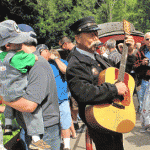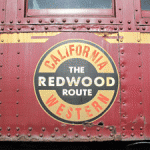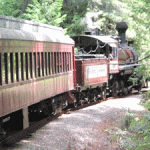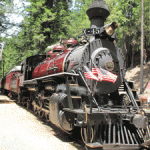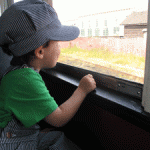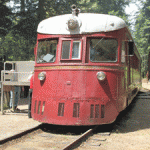It has been twenty years since I first rode the Skunk train out of Fort Bragg. At the time I had limited train travel experience and found myself captivated by the romantic feel of the old steam train as we plied our way through the redwood forest. Since then I’ve come to appreciate train travel as the best way to get anywhere. It may not be fast but the connection to people and places is without parallel. This summer I took another ride on that old Skunk train and once again found myself caught up in the nostalgia of train travel.
The old California Western Railroad (CWR) began regular passenger service from Fort Bragg to Willits on June 25, 1912, after 27 years of inching their way through the mountains from the coast. It is just 22 miles, as the crow flies, from Fort Bragg to Willits, but the rugged terrain requires 40 rail miles to make the connection. The grade was steeper that most trains at the time and the track often tightens to 33 degrees to cut back and forth across the mountains.
The purpose for the rail line was to support the logging industry but once train service began they couldn’t keep passengers off of it. Passenger services grew until the 1920’s when the automobile started to erode demand. To maintain service the CWR scaled back the steam trains and ran more cost effective gas-powered motorcars. It was the smell of the gas fumes that brought about the nickname the “Skunk”. By the 1940’s diesel engines took over and the steam engines were scrapped. But, in the 1950’s things started to turn around. Tourist interest in the old Skunk train started to pique. In the 1960’s they were scavenging the nation for old steam engines. With a steam locomotive from Oregon and passenger cars from Pennsylvania the new “Super Skunk” came into service on July 10, 1965.
Riding the Skunk train is a fun, relaxing, and exhilarating adventure. Today you can ride the steam train, motorcar, or diesel locomotive; each providing a different experience in the history of train travel. Personally, I am a fan of the old steam train. There is nothing quite like the sight of the steam wafting up through the trees as you wind your way through the forest.
We rode the Super Skunk #45 on a Wednesday. It was busy for a weekday but not too crowded. Stepping into the old coach was like a step back in time. The springy seats flipped back and forth to easily accommodate a change in direction. We flipped ours so that we had seats facing each other. Over the loudspeaker the conductor cautioned us about the old sliding windows that occasionally came slamming down without warning. His voice kept us informed and entertained during the roundtrip ride to Northspur, halfway between Fort Bragg and Willits.
People were in constant motion during the trip. Mobility is one of the best things about train travel. I grabbed a couple of coffees in the dining car, carefully juggling the hot cups as I staggered back to our seats. Other people made straight for the outdoor viewing car in the middle of the train, jostling for good spots to see the engine when it rounded a bend. The train singer, Greg Schindel, moved up and down the aisle keeping his balance while he played a harmonica, guitar, and sang traditional train songs. With is handlebar mustache and period attire he has been entertaining passengers on the Skunk since 1988.
The view from the train was beautiful. Closer to the coast the fog made the forest seem almost ethereal but as we moved up and inland the weather warmed and the sun made its way through the towering giants. It smelled of earth, trees, and train mist. The old “stations” we passed were mere shadows of the past but with an old cabin here and there you could still imagine life back in the early logging days.
At one time there were about 2500 people living along the California Western Line. In the early 1900’s the town of Alpine (18.1 miles from Fort Bragg) had a hotel, post office, and hundreds of people. Today there are just a handful of families that still have homes along the line. Without the train they are completely cut off from the outside world. They live without electricity, generators, or road access. Official postal service stopped in 2003 but the California Western Line is one of the few train lines that still has flag-stop service. If you stand along the line and waive down the train, it will stop for you.
Northspur (21.3 miles from Fort Bragg) was our lunch stop and turnaround point. It is a simple outpost serving the daily barrage of tourists that stop for food, drink, and souvenirs. While we ate lunch we watched a small group of people transfer to the motorcar and continue on to Willits. Compared to the imposing Super Skunk #45 the motorcar looked like a streetcar in the middle of the woods. It would be a fun ride, traversing the mountains on the tight curves leading into Willits. Maybe next time… Our steam engine received a new supply of water and turned around to reconnect at the opposite end of the coaches. Before long we were headed back.
Having taken in the sights during the ride out, we found ourselves lazily enjoying the view from our seats, listening to the rhythmical klickety klack of the train, feeling the gentle rock from side to side. With my legs stretched out and my toddler in my lap I did what I often do on trains; I slept, interrupted only by the occasional “woot woot’ of the steam engine.
Additional Source: “Rails Across the Noyo, A Rider’s Guide to the Skunk Train”, by Katy M. Tahja, 2008.

